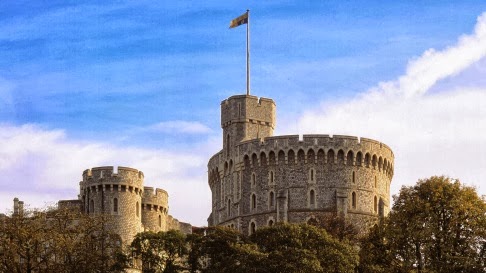 |
| Image Courtesy of The Royal Collection Trust |
Today, the castle is a mixture of architectural styles ranging from the medieval to the very modern. For nearly one thousand years, the castle has undergone almost-continual reworking, sometimes for aesthetic reasons, sometimes for practical reasons, and sadly, because of great tragedy.
The castle’s main structure is comprised of three bailey wards (a “bailey” being a courtyard enclosed by a curtain wall) and a central keep (a tower). The castle walls, however, house a variety of structures, and, in fact, a small village originally meant for the people who worked in the castle.
To recount the last nine hundred years of the castle’s history would make for a rather ponderous blog. Discussing the rooms alone—including the famed St. George’s Chapel and lavish State apartments—would take innumerable words.
So, we’ll try to hit the highlights.
As is the case of any structure that’s survived that long, the castle has developed over time, changing as needed. Since the time of its initial construction on thirteen acres, additions and changes to the façade of the castle have been carried out in mostly a medieval style in keeping with the original purpose of the site.
William the Conquerer didn’t use the castle as a residence. Henry I was the first to live there, and, in fact, was married there. His son, Henry II, began the first building project at the castle since 1067. These changes were largely made to keep the castle from tumbling down. Massive foundations were built and the keep was reinforced. During King John’s reign, the residential quarters were improved, and, then, the entire castle was repaired after a series of sieges left it weakened. Henry III added three towers to the structure.
Edward III ordered that the central palace be rebuilt, adding new windows and making the overall structure, decidedly more unified in a Gothic style. Then, as is often the case with castles, it went through a couple of centuries of being seiged, released, attacked and otherwise battered. It became the place of many births, deaths, weddings and burials.
Henry VII was a sporty, fun kind of fellow, and added a tennis court and other amenities which would make his favored palace more comfortable. He also had the gates widened so that more of his friends could enter at once. Edward VI didn’t find the castle at all comfortable, notably stating, "Methink I am in a prison, here are no galleries, nor no gardens to walk in.” Edward attempted to make the castle more attractive by bringing in parts of English abbeys to be used for additional decoration.
Conversely, Elizabeth I very much enjoyed life at Windsor and took steps to reinforce the structure. By the time of James I and Charles I, the castle became more of a hunting lodge and a place to display art than it was a fortress.
In 1660, with the Restoration of the Monarchy, the castle (and all of the Royal residences) was substantially repaired following a long period of upheaval and revolution. Charles II had the castle fully “modernized,” added buildings and, most importantly, commissioned the regal Baroque interiors which are considered the finest of their kind in Britain. For the next century, until George III’s reign, the castle saw the completion of very few construction projects.
George III worked with architect James Wyatt to completely remodel the building—changing the style of the front façade to a more dramatic Gothic design in 1760. The Royal apartments were remodeled and refurnished at a cost of £150,000 (about £100 million today). George IV also expanded the palace.
Queen Victoria made Windsor Castle her primary residence. Prince Albert died there, leaving Victoria dubbed as “The Widow of Windsor.” Victoria made several changes in décor and added a private chapel. During her time at Windsor Castle, water was successfully piped into the structure for the first time. Her son, Edward VII, set about a massive redecoration of the palace, personally moving art around himself.
By the 1950’s Queen Elizabeth II made Windsor Castle her permanent weekend home and made sure that the castle was technologically up-to-date. Elizabeth II has long declared Windsor Castle to be her favorite home. In 1992, a terrible fire spread through Windsor Castle when spotlights used during renovation of the private chapel set off a blaze. Nine of the State rooms were completely destroyed, the Great Hall was gutted and one hundred other rooms were very badly damaged.
To pay for repairs to the castle, Queen Elizabeth II opened part of Buckingham Palace to tourists. Though not without controversy, the damaged parts of the castle were rebuilt. Some areas such as the Crimson Room were designed to approximate their Baroque style. Other areas, such as the Great Hall, were rebuilt in a more modern style which complimented the original architecture. My thought is that the castle has seen changes over the many centuries of its existence, so it’s not shocking that, in this phase of rebuilding, a style which reflects the current time period isn’t terribly shocking. I applaud the desire to recreate spaces as they were, but I can understand the wish to modernize in this particular instance. Luckily, most of the art and precious antique items of value had been removed because the castle was already being renovated at the time of the fire. So, the loss of artifacts was not as great as it could have been.
Today, the castle is fully repaired and expertly maintained. It is open to the public who can tour the historic structure and view its impressive collection of antiques and art.






No comments:
Post a Comment